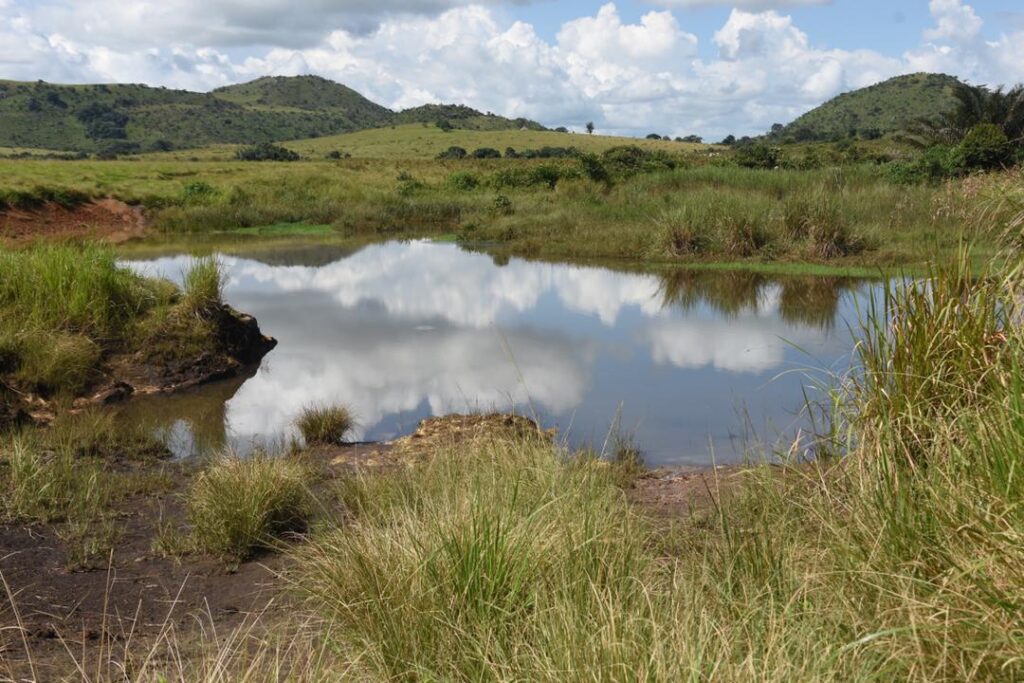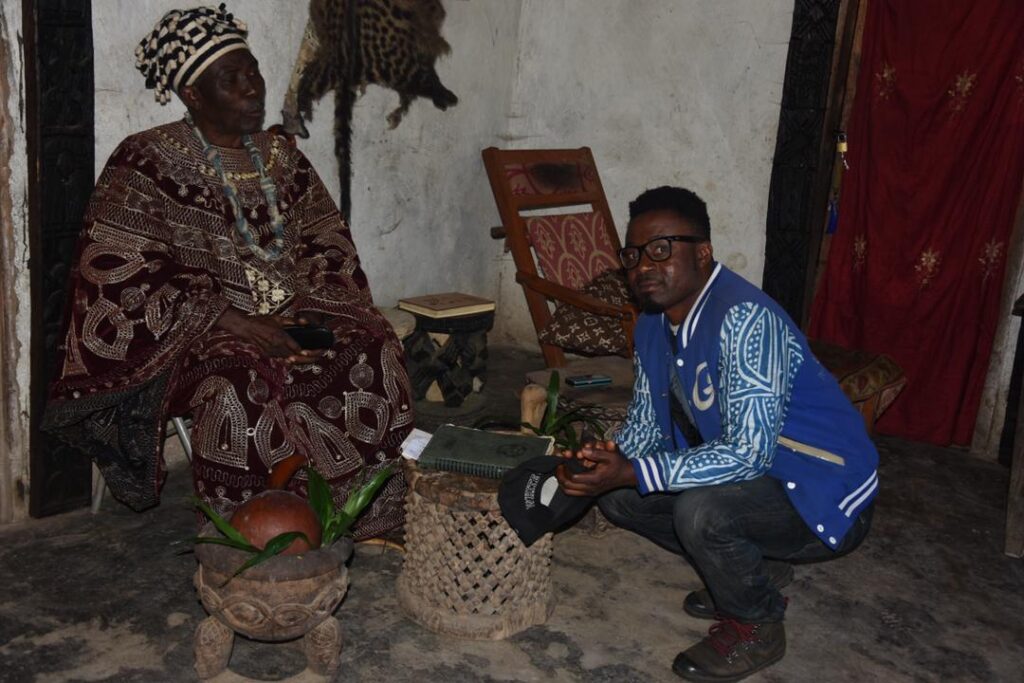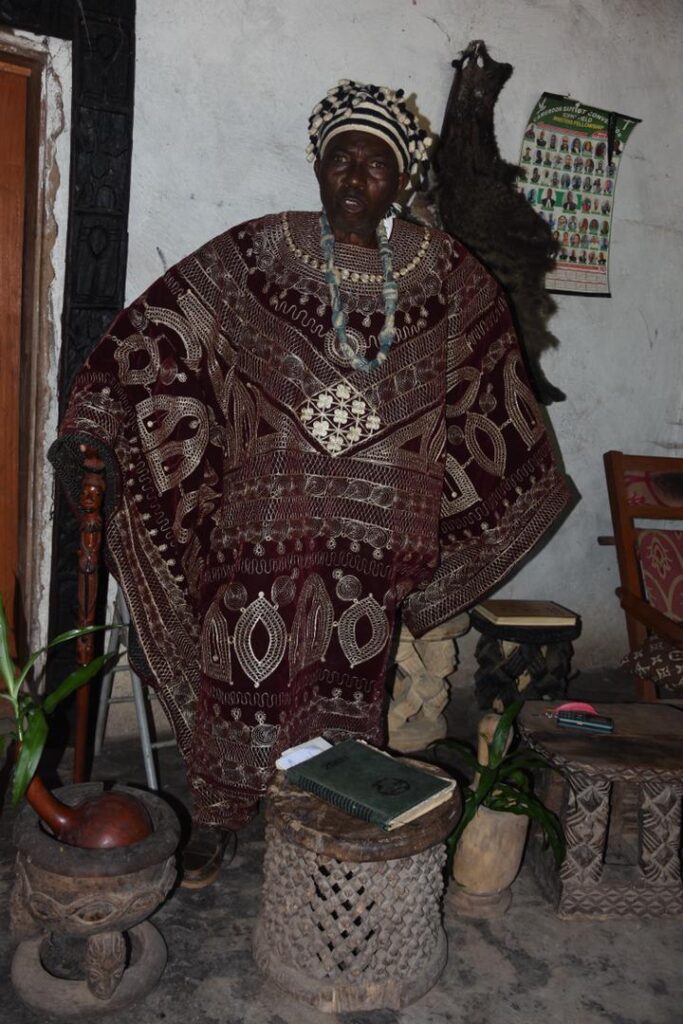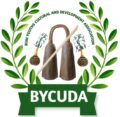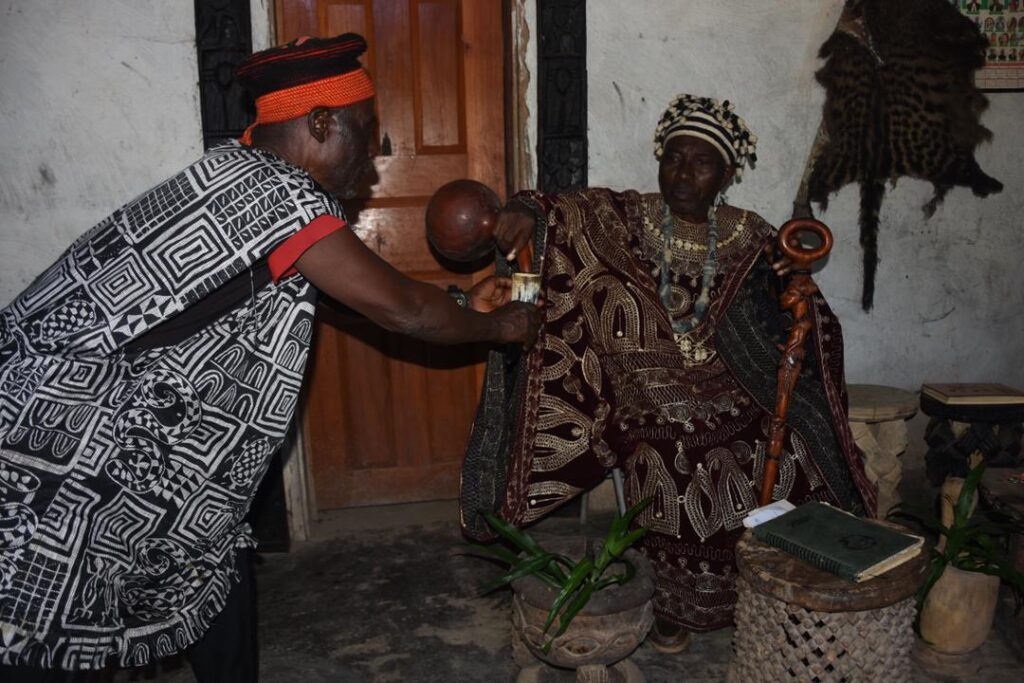
Saff Fondom-Origin-Migration-Development.
The Saff people constitute one of the eight Fondoms that exist in Bum Sub Division of Boyo Division in the North West Region of the Republic of Cameroon.
Saff oral Tradition strongly hold that the Saffs are TIKARIS, Saff people left Tikari and was led by godess Nesakajeki to Nkor, Din, Kitoya Mulung, Ngen and Kichowi. She finally disappeared on the Hill of Nesakajeki where Saff people finally settled in the plateau hill.
The Bum fondoms are of the tikari group that formed up themselves in the time of Wars as they find difficulties in wars with Kom, Nso etc. So, they formed up as “Abum”, a union known as a bundle, they acted like brothers who had swear to live together and see no blood of each other.
When a Fon is lost, the Fons children are called upon to get the successor where the Fon’s will is brought and read, and then Njinga is called to officiate as the Head of the Seven Kingmakers. Then the Fon’s successor is got and crown by the Kingmakers in the kwifon’s House.
When the Fon is Lost All caps are removed from all Heads. Only the sub chief Njinga wears a special leaf on the head. Celebrations continue for a period of thirty days. After thirty days the caps are again given out and another day is immediately fixed for the presentation of the newly enthroned Fon.
Associates to the Fon of Saff (Njis):
- Njinga of Atung
- Njikichia of Njinisung
- Njikilang of Ngen
- Njitor of Mulung
- Nji Yam of Njinijuo
- Nji Bangha of Fungi
- Nji jah of Kichowi
- Nji Joko of Bum quarter Bamenda
- Nji Georges Nsah of Saff
- Nji Jum ofKituma
- Nji Mbang of Ngen
There are seven Ntul Members that makes up the Kwifon of Saff: 1. Fon - Njis
- Sheys
- Tantohs
- Chinda
- Mbenglo
- Kimeng
The war society (Njong) Members - Sheys
- Beh Ndah (Talap)
- Nforghama
- Tanjong
- Tawah
The Fon and sub chiefs are always present when called on occasions needed. The kwifon is the acts like the Supreme High court of the Fondom, dictates crimes and punished offenders.
Fubeun, is the women society which acts as the the kwifon for the women who can call the kwifon and the Fon to order.
AREA:
The Saffs occupy about half of the total area of Bum Sub Division with a common morphology of plains, plateaus, mountains and rivers. Enriching her hydrology. Her external neighbors are Kom and Noni to the South and East respectively in Grass field.
POPULATION:
The Saff Fondom is not only the largest in vastness, she also has an age over some Fondoms. The fondom holds a little over half of the population of Bum. Her estimated population stands at 16 179 inhabitants of the 30.000 Bum population.
ADMINISTRATION:
The Saff Kwifon is the supreme governing society and the Fon of Saff is the paramount representative of God and the people in the physical. The Fon is based in the Saff Palace that is the Headquarters of the Saff people. The Fon’s Palace is known as “Tawk” which is effectively called TawkaSaff. The Fon can be called in other terms as BehlakaSaff which means the Father of the Saff Country. The Nji’s and the Ardorate are next in administration in the Saff Fondom acting as the subchiefs with confined areas of jurisdictions. Next to the sub chiefs are: Sheys, Tantohs, Nforghamas, Chenjongs, behteghs and Behbins.
Yaahs, Nefon, Behfon, Yenatok, Wantoh and the Chindas are all titles within the Palace.
JURISDICTION: There exist Saff rural council in Lakasaff and others at the level of Saff sub chiefs and behteks. Kwifon handles cases patterning to witchcraft and superstition.
RELIGION:
Early Saff people were animists and believed in their goddess Nesakajeki who settled on Nesakajeki Mountain at Lakasaff. Nsafwun has been the day for all Saff people to stay back at home and worship the goddess and the day of the Kwifon.
Tuut of Saff exist and it’s in the tuut house that the Saffs meet and invoke the powers of the goddess for blessing through their ancestors. Rituals are also performed in the burial ground house of the late Fons of Saff known as “Ifum”. In 1923 the Saff sons: Joseph Mamadu and Kiyokiton Kiteh introduced the Baptist Church from Bimbia Victoria in Ngen and the Catholic Church from Fernando Po in Fonfuka respectively. The Saffs largely became Christians through the evangelism of these two sons further facilitated by missionaries of the Hillionist Fathers.
SOCIALS:
The social life of the Saffs is organized: Stratified as the nobles and commoners mixed freely together. Yet in each group succession is by paternal Lineage.
Cultural practice of inter- marriages amongst the Saff is common. Njanghawan is a dance, styled during childbirth, which together evolved to Njangi groups. Juju societies in Saff Fondom do participate during death celebrations annual and national day celebrations notwithstanding.
Mbengha Bangha, Kaikiyungm, Kalikuma, Mbashowa, Nyanmfu, Nenetang, Kwaah, Adeng Kopli and war club of Manjongs are masculine dance groups and societies of the Saffs amongst a huge of others.
EDUCATION:
In the domain of education, the sons and daughters of Saff are far advanced in this area in both formal and informal education, spurred by the early introduction of Christianity. The Saff Fondom has three Youth Centers and a First school leaving Examination Centre. Eleven Primary Schools and two Government Secondary schools in Saff and Kichowi.
HEALTH:
There exists traditional method of healing patients by herbalist and witch doctors. Modern Health centres exist with a lone Baptist Laboratory Post in Kichowi and the SADA health post. ECONOMY:
From early civilization as of now, the staff has largely been involved in agro pastoral activities. Under agriculture cereal as corn, beans, groundnuts, tubers as yams, cassavas and cocoyams, fruits as bananas, peas pineapples, Mangoes, paw paw and vegetable oil as palm oil remains the predominant product. Fufu corn and vegetables added to roasted chiken “Khati Khati” is their stable food. Cattle, goats, sheeps, and birds as fowls constitute the pastoral activity which is the strong hold of practice of the Fulani’s.
MAJOR SAFF VILLAGES:
Saff, Ngonafusi, Kituma, Fubonlu, Tahmbet, Bouk, Youndeh, Kichowi, Kitoya, Kimoli Mulung,
Ngen, Kitchako, Ngunakimbi and Dang
INFORMATION ABOUT SADA
SADA started in 1983 with just the following elites of the Saff Fondom trying to rally and bring all Saff sons and daughters together for the development of Saff. The following elites some of whom are of blessed memory headed SADA at that time:
Pa Shey Yomta,
Tantoh Dom Alfred Tangah,
Tantoh Dom of Kichowi,
HRM Fon Ngong Ngoung Solomon,
Mr Kiteh Augustine,
Pa Joseph Lon and Pa Jum.
SADA at that time was called Saff Communities Local Development. The name was later changed in Yaounde in the year 2000 to Saff Area Development Association (SADA) and was headed by:
Pa Wango Francis and now by
Mr. Tangah Williams Wabua.
The objectives of this association are as follows:
To foster unity, peace and development among the people of Saff.
To promote socio-cultural and economic development of the Saff area in particular and
Bum as a whole.
To educate and mobilize members towards national development and communication
through self-resilient initiatives.
To promote and encourage healthy competition and collaboration amongst ourselves. To initiate strategies aimed at improving the use of land and environmental care. To initiate and encourage investment in the Saff area.
To participate in poverty alleviation and enhance the wellbeing of members.
To promote education of Saff children specially the girl child
The following activities can be listed as our success stories:
Renovation of the Saff Fons palace in 2014,
Provision of a bundle of Zinc to GS Ngen,
Financial supported to the Kichowi Health post,
purchase of spades and diggers for community work in Saff and Kichowi,
Followup on the creation of GSS Saff,
Invitation of the Senior DO for Boyo, the Sub Divisional officer and assistant for Bum, the Survayor and the Mayor of Fonfuka council for Land allocation for GSS Saff was all sponsored by SADA.
As of now, the following branches are existing:
Yaoundé Branch with Gwuba David as president Douala Branch Gwan Elkana as president
Tiko Branch, pending elections
Penja Bamenda pending elections
Saff centre Gwan Ignatius as president Kichowi Ferdinand as president
Fonfuka HM Gwota as president
Ngunabum Kanghi John as president
Envisaged projects:
Bring to completion the already functional SADA health post,
Pipe born water.
and install Solar polls along the major centers and streets in Saff.
Compiled and Submitted by Sada Executive Under The Leadership Of Tanga Williams (January 2024)
[01:42, 30/03/2024] Desiere elite Android Class: Kichimi Area Development Association (KADA)
KADA has as vision to build a thriving and empowered Kichimi Community to foster sustainable development.
Mission: Dedicate to initiating and supporting development activities that enhance the overall quality of life in our community. - 1st President: Pa Francis Chosen (blessed memory)
- 2nd President: Ndi Abel
- 3rd and current: Wanlo Amos
Projects Realised: - Constructed two classrooms for GS Kichimi
- Constructed two bridges in Kichimi
- Partner with Fonfuka Council to construct the Mistake Fonfuka road network passing
through Kichimi. - In 2024, the association awarded Scholarships and recruited one staff to encourage
back to school in GS Kichimi.
Envisaged projects. - Construction of classrooms,
- Award of scholarships
- Recruitment of Community teachers
- Enhancing access to Kichimi through the construction of roads.
